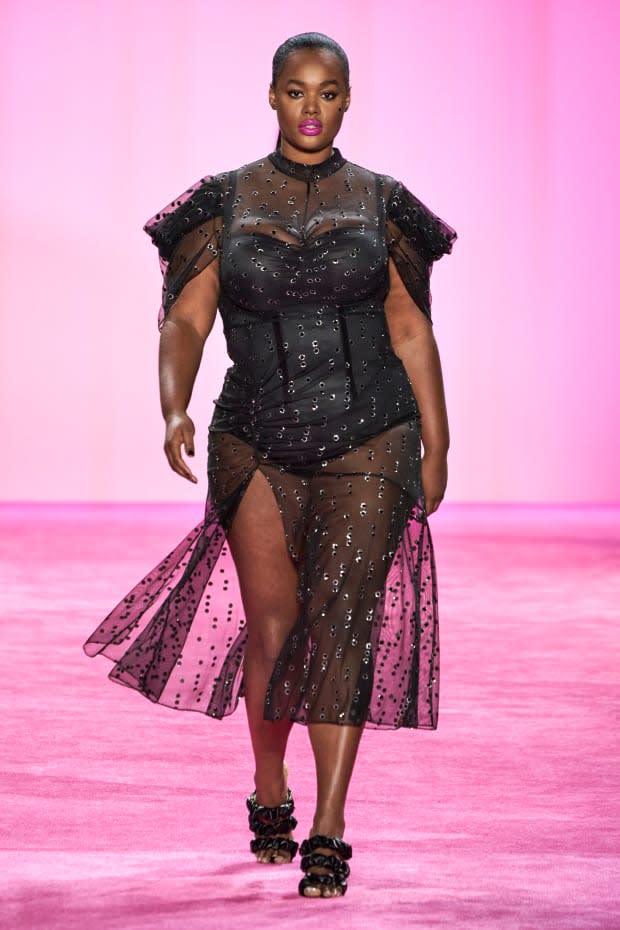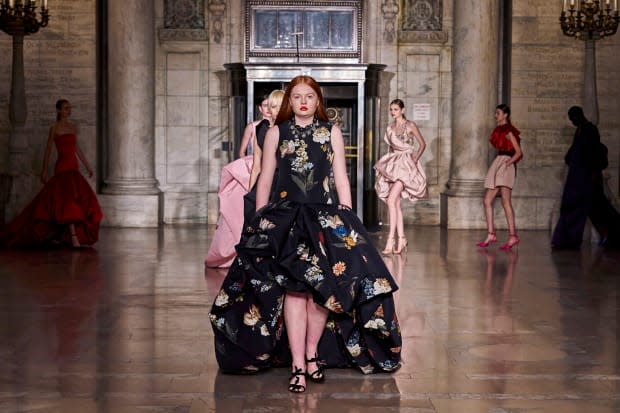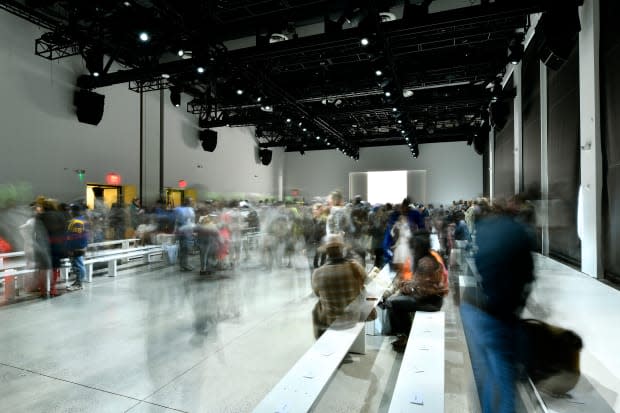What's the Best Way to Talk About — and Measure — Size Inclusivity at Fashion Week?
At the Fall 2020 shows, it felt like the momentum around body diversity on the runway was slowing down at times.
As more pressure is placed on designers — from both customers and people in the industry — to be size-inclusive, a lot of attention is placed on how many curve models are sent down their runways at fashion week. We'll cite that number (normally tallied by sites like the Fashion Spot) each season, as shorthand to evaluate how significant that shift towards body diversity has been.
But considering how easily that number can be inflated when a brand like 11 Honoré hosts a show with an all-curve number or deflated when a certain in-demand model is, say, taking a season off, is it really the strongest metric?
For Fall 2020, there were no plus-exclusive brands on the New York Fashion Week calendar. And though a few designers known for casting diverse shows — Christian Siriano, Tadashi Shoji and Chromat, namely — did include a range of curve models in their lineups, it didn't feel like as much as a priority across the board, as it had been in past seasons.

There are many valid reasons as to why that's happening: The shows in September tend to get more eyeballs, so some labels might choose to only present their collections then, as opposed to twice a year. Also, because of the annual CurvyCon, more of the plus-size community travels to New York in September, creating a bigger turnout at events and shows hosted during that season.
The seeming dip in plus representation on the runway for Fall 2020 should raise concerns. But like when we're talking about size inclusivity retail, fit and so many other aspects of the fashion industry, a single number doesn't paint the full picture. Seeing curve bodies on the catwalk is important, of course. But we should also be scrutinizing other parts of the fashion-week machine — and get on the same page when it comes to what "inclusive" means.
"We first need to start to see how we're going to define size inclusivity in fashion," says stylist Meaghan O'Connor, who currently works with clients sizes 12 and up. "I have to view things with a microscope because [do these brands offer clothes] to cover three out of my eight clients, or is it going to cover eight out of my eight clients? That's a huge difference. It may not be on the runway, it may be hidden on page three on their website, and that's the information that I want."
Because it has become such a buzzword, some brands have stretched the meaning of "size inclusive," to put it lightly. (It's not uncommon to come across marketing for a collection that goes up to an XL that bills it as "inclusive.") But who gets to claim that? Surely, at the very least, it should reach a size 16/18, which has been found to be the average size of the American woman — or should it go much higher?
Many argue that a brand's runway should accurately reflect its clientele. If a designer goes up to a size 24, then its fashion week show should feature models sizes 0 through 24, since that would not only give people a chance to see how the clothes fit across its full range, but also make customers of every size it sells feel welcome. And simply getting the word out that a brand sells plus sizes is important — after all, if you don't show your curve clothing on curve models, how will curve shoppers know to shop your brand?

"It starts to feel personal," says influencer Kelly Augustine in regards to designers offering plus but not showing it on the runway. "It may be offered at a department store, but on the runway, you just don't want it to exist."
She adds: "If you make clothing in that size, why wouldn't you want people to see it because you want people to buy it? Seeing clothes on someone who is a size 10 — I can't relate to that."
Pushing to represent more diverse, plus body types on the runway — as in, a range from 16 to 22 and above — is a great indicator of whether a brand understands the nuance of this issue. Often, if that's not the case, it can be traced back to another issue that needs to be addressed: who the people making decisions behind the scenes are.
"Do you have body diversity amongst your employees, amongst the people who are in decision-making positions?" asks Sarah Chiwaya of the plus fashion blog Curvily. "Often at a lot of companies, the only plus-size people they'll have will be people in customer service roles or things that aren't really able to make decisions about what the marketing looks like, what they're going to focus on for consumer-based and demographic pushes and things like that."
If diversity is not reflected in those making the decisions, then failure and slip-ups are almost inevitable. Both Augustine and Chiwaya have worked with brands before to do both consulting and damage control, and they've witnessed firsthand the lack of knowledge about the plus market that comes from an all-thin team.
"If there's just one or two plus-size people shouldering the brunt of the responsibility of that, that's unfair to them, of speaking for the plus community," adds Chiwaya. "But often there are zero plus-size people. So, it's not unfair burdens, it's just these issues aren't being considered, these questions aren't being asked."

When it comes to the fashion week runway, this conversation should start from the moment planning for a collection begins — that way, it's factored into the sample-making process, which then has an impact on casting, says Mina White, director of IMG Models.
"In order for the landscape to completely evolve, the samples are such an integral and important part of the puzzle," she tells Fashionista. "[They need to be] thinking about the collection as a whole from inception and about how they want to best represent women."
IMG Models represents some of the most used curve models in the industry, from Candice Huffine to Marquita Pring to Precious Lee. And in recent years, White has seen an increased interest in designers to reflect size diversity on their runways. But without the samples available — especially considering the fact that casting happens only a few days before a show takes place — that's an impossible goal to accomplish.
"I think there really is very much an education process that has to happen," White says. "Some people will say it's very easy to grade up but I think that a lot of people I've seen who have tried to grade up have also done it badly, not really taking any accounting to make the clothes look shapely as they get bigger."
Related Articles:
How Patrick Herning Became a Leader of Size-Inclusive Fashion After a Career in Tech
Has Fashion's Tokenism Overlooked the 'Inbetweeners'?
Part & Parcel Talent Aims to Bring True Size Inclusivity to Modeling
Even if a designer has plus on the runway, reflected in the company's makeup and in the audience (another important consideration) — what happens after fashion week? Inclusivity is not a topic that should only be thought of two months out of the year.
"Between the time of fashion month and what actually gets put on the racks or on the sites, a lot of what you think is coming gets dropped in production," explains O'Connor. "If you're talking about size inclusivity during fashion week and you as a brand are getting that buzz...and then two months later, we go to purchase it and it's not available, that's a problem."
Post-fashion week, it’s customary for designers to hold market appointments for buyers, press and influencers to see the collection once more. Patrick Herning, founder and CEO of 11 Honoré, says that, over time, his team has seen brands take an increased interest in exploring opportunities in sizes 12 and up at that time.
"As a digitally-native retailer, we have a tremendous amount of data that can support [the importance of inclusivity] and when you look at the success we've had with brands like DVF, it really allows us to go in armed with sales figures and data to support the thesis that if you invest in this customer, there will be a tremendous return for your business," he explains.
There's no "one size fits all" way to measure size inclusivity at fashion week — it's runway, but it's also front row, it's also staffing, it's also retail buys. When body diversity becomes integral to a brand is when the power of plus-size fashion becomes strongest. Each designer may tackle it from a different angle, but the important thing is that in 2020, they start somewhere.
Want more Fashionista? Sign up for our daily newsletter and get us directly in your inbox.
